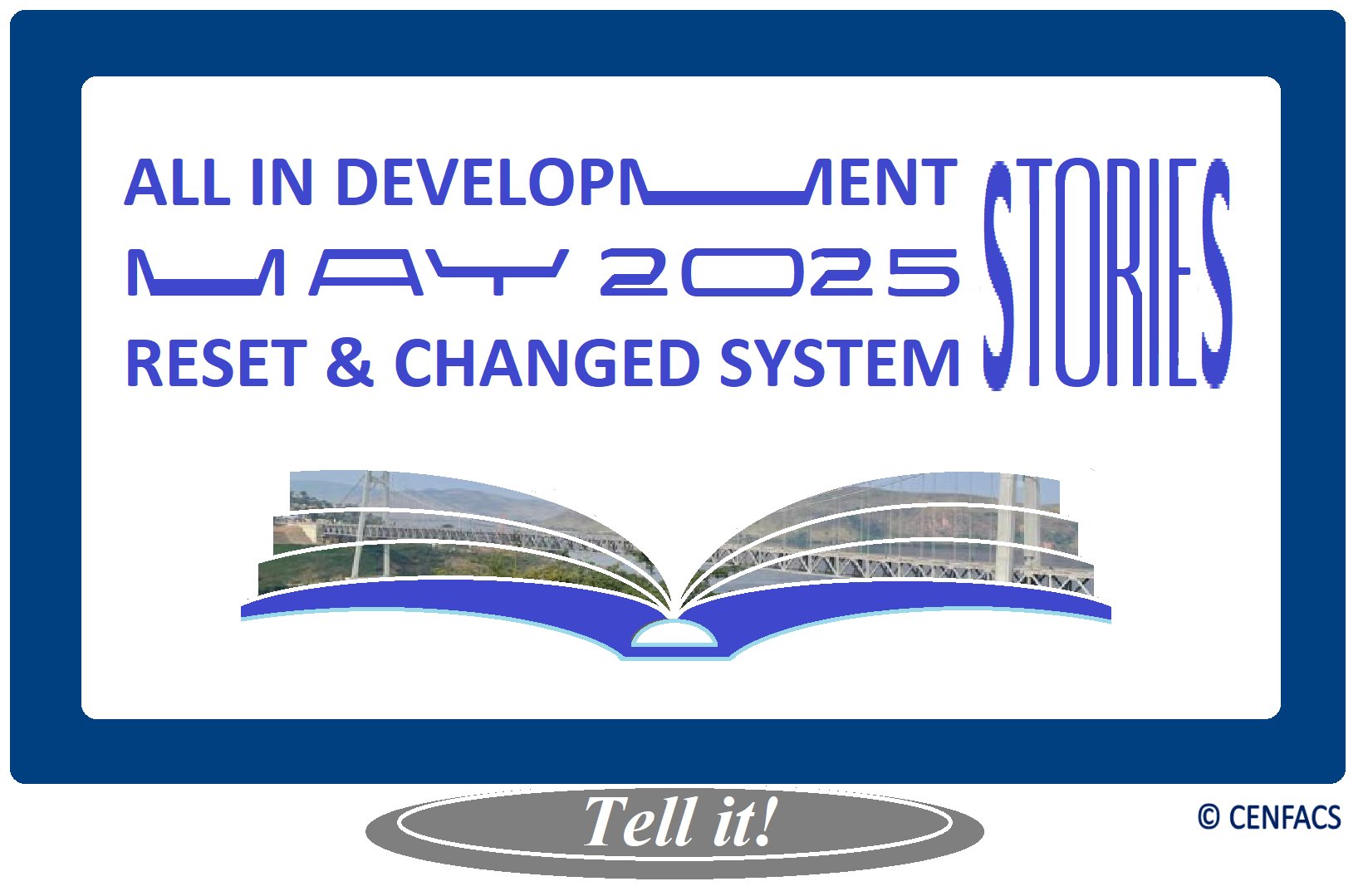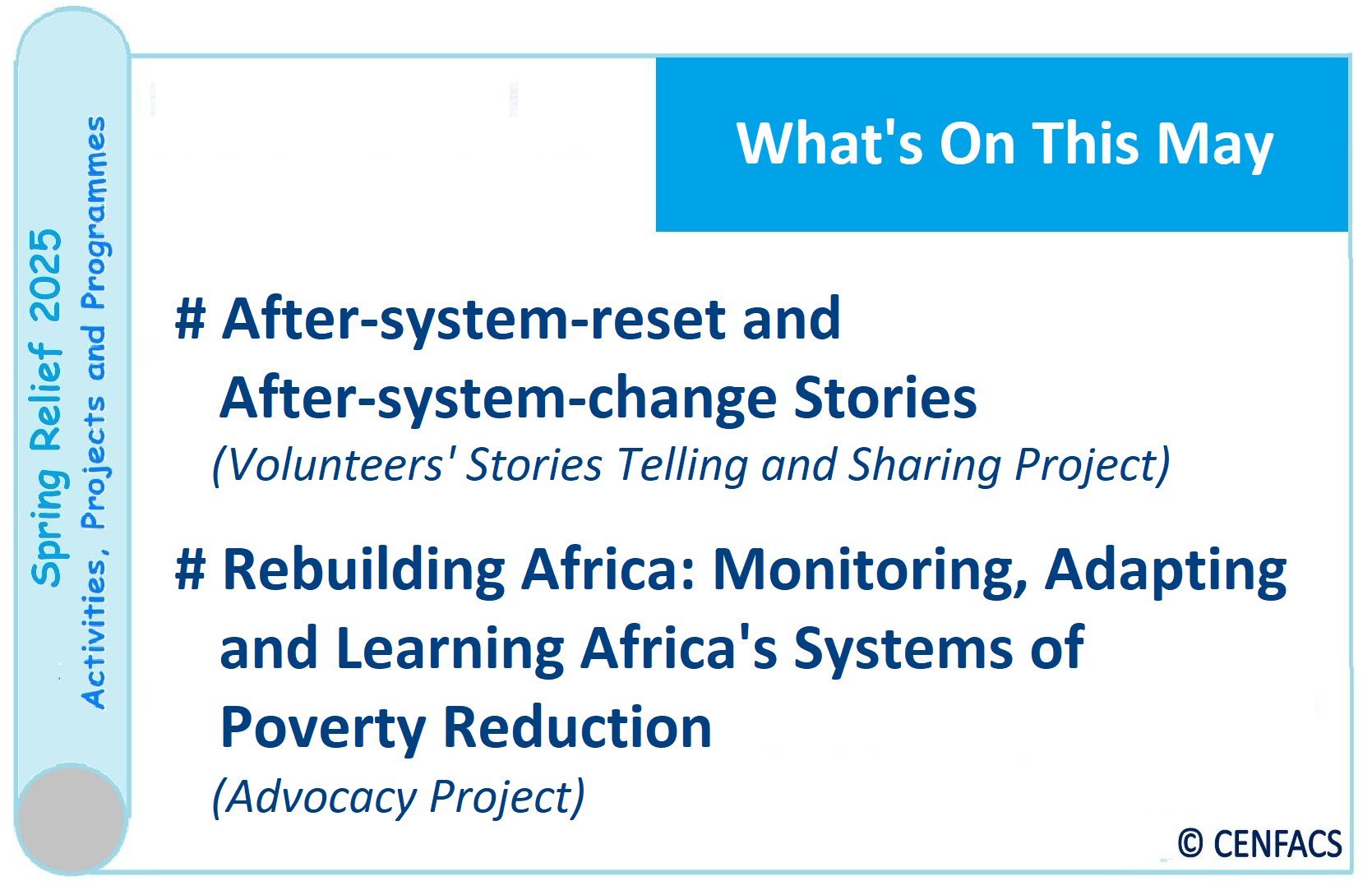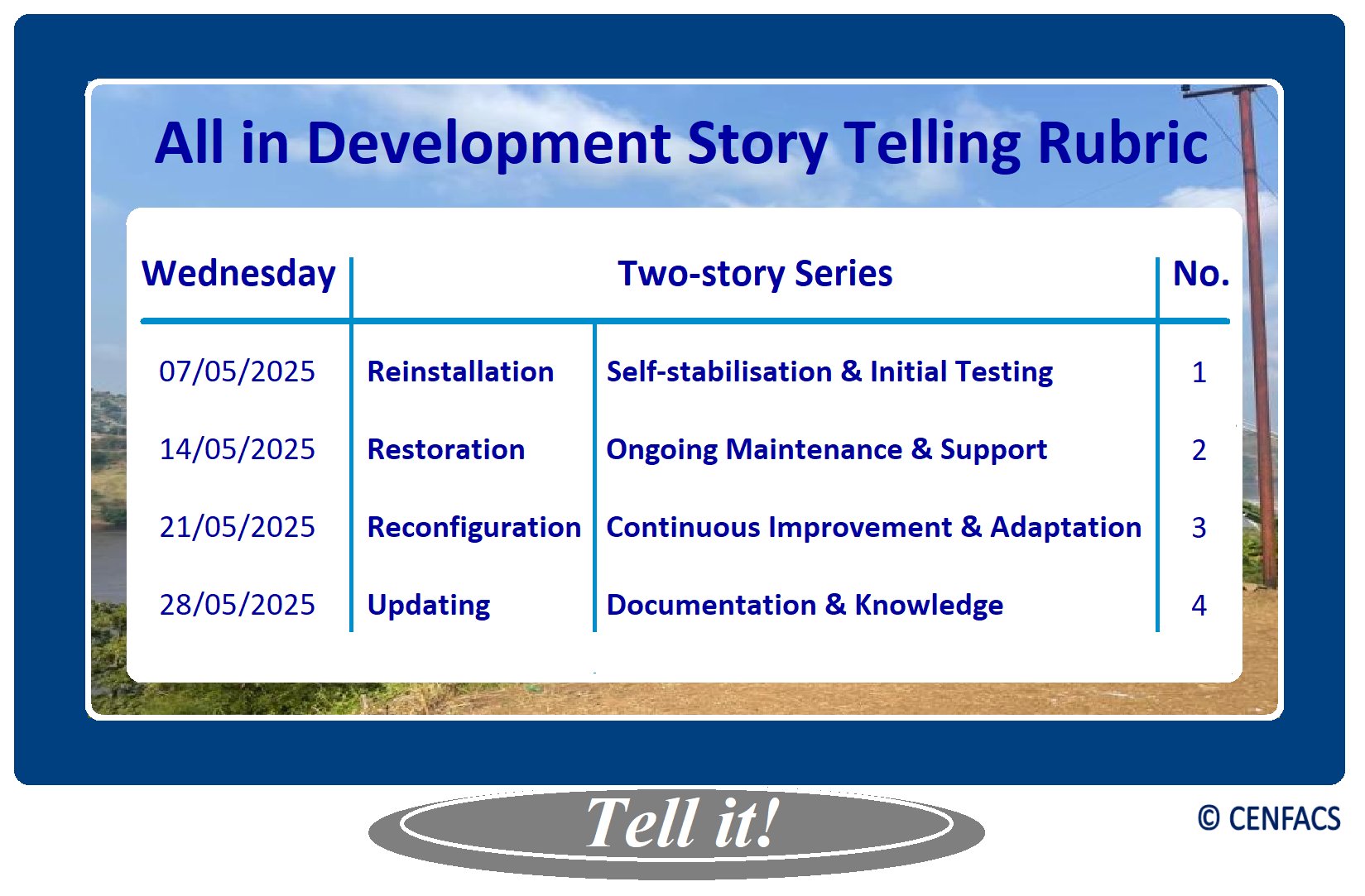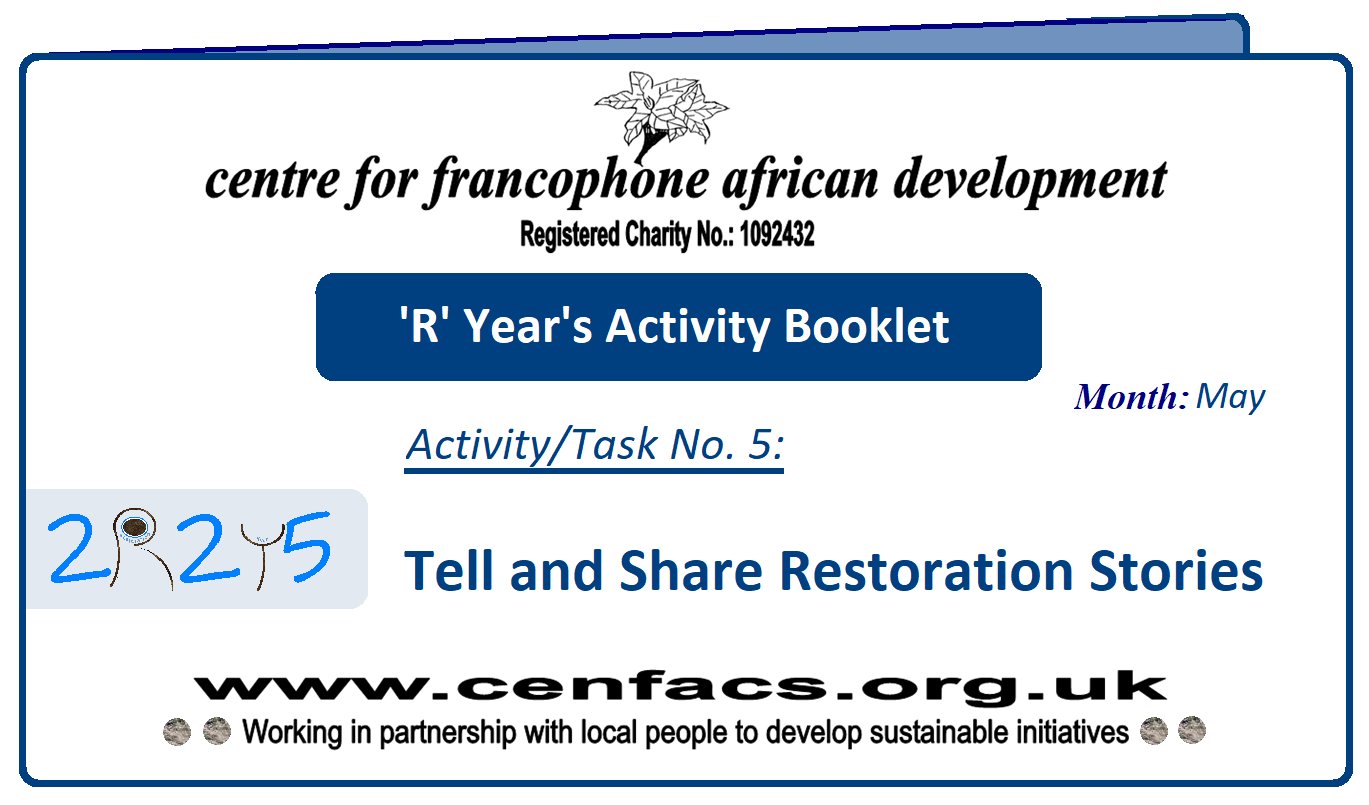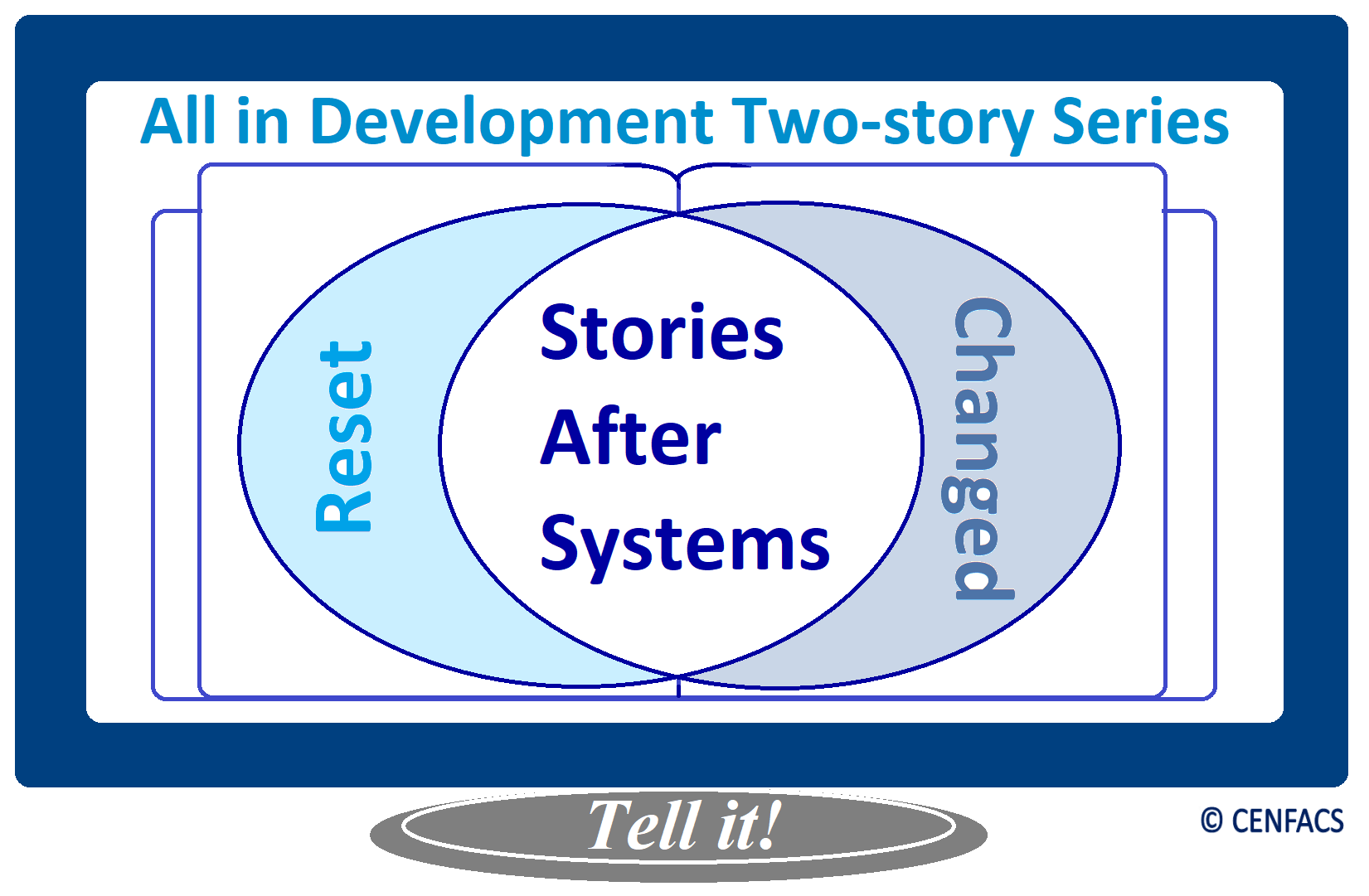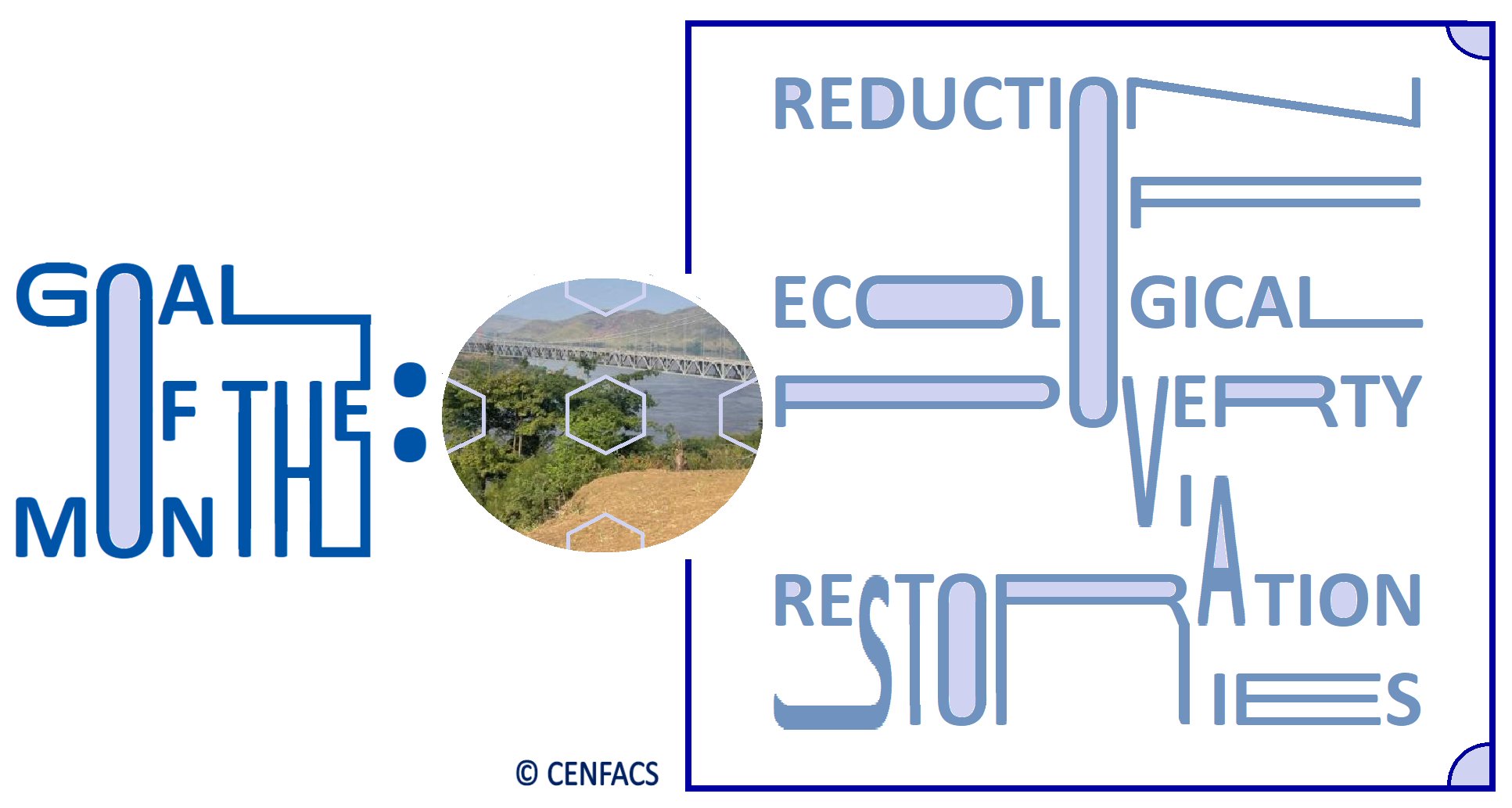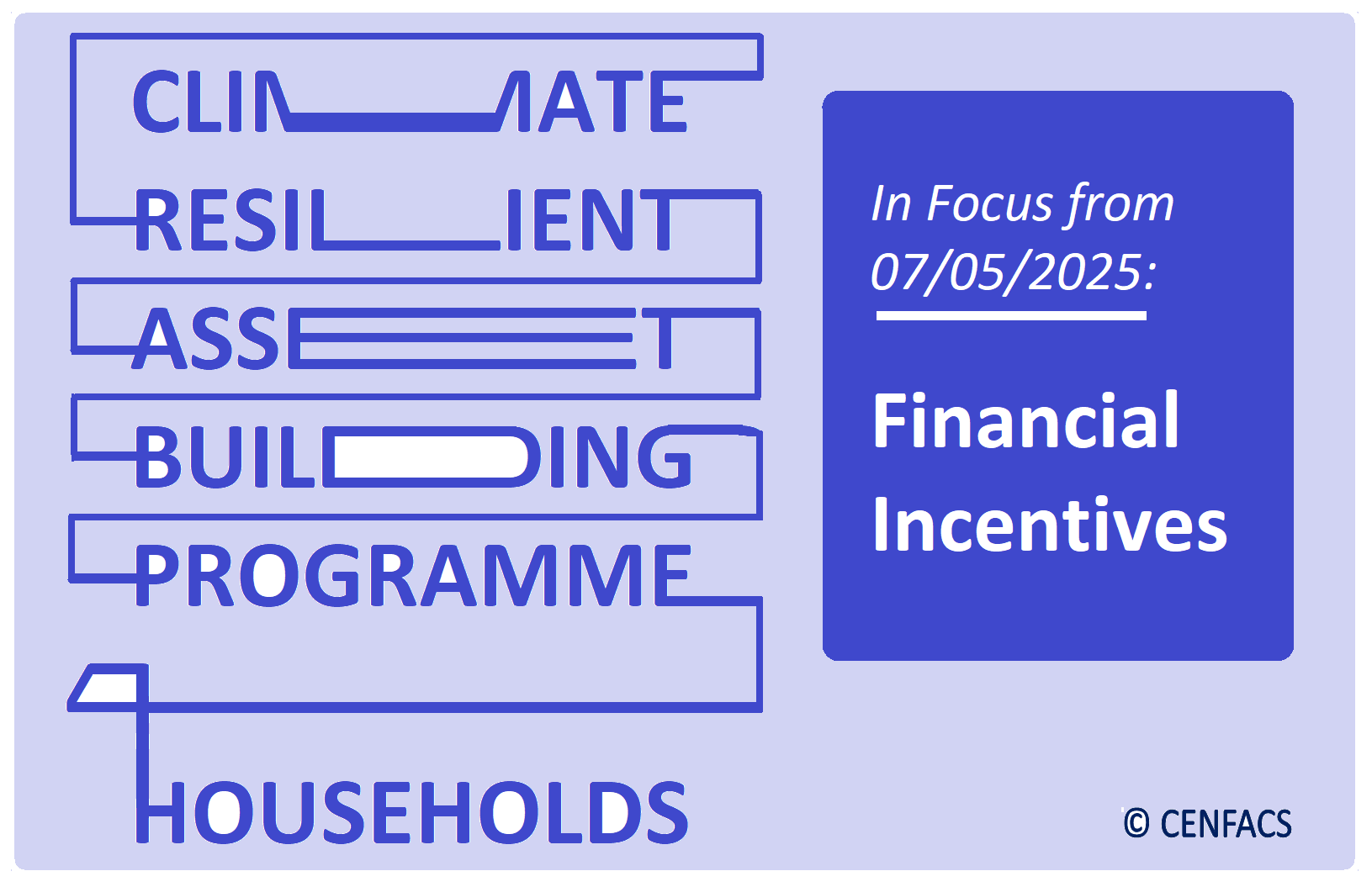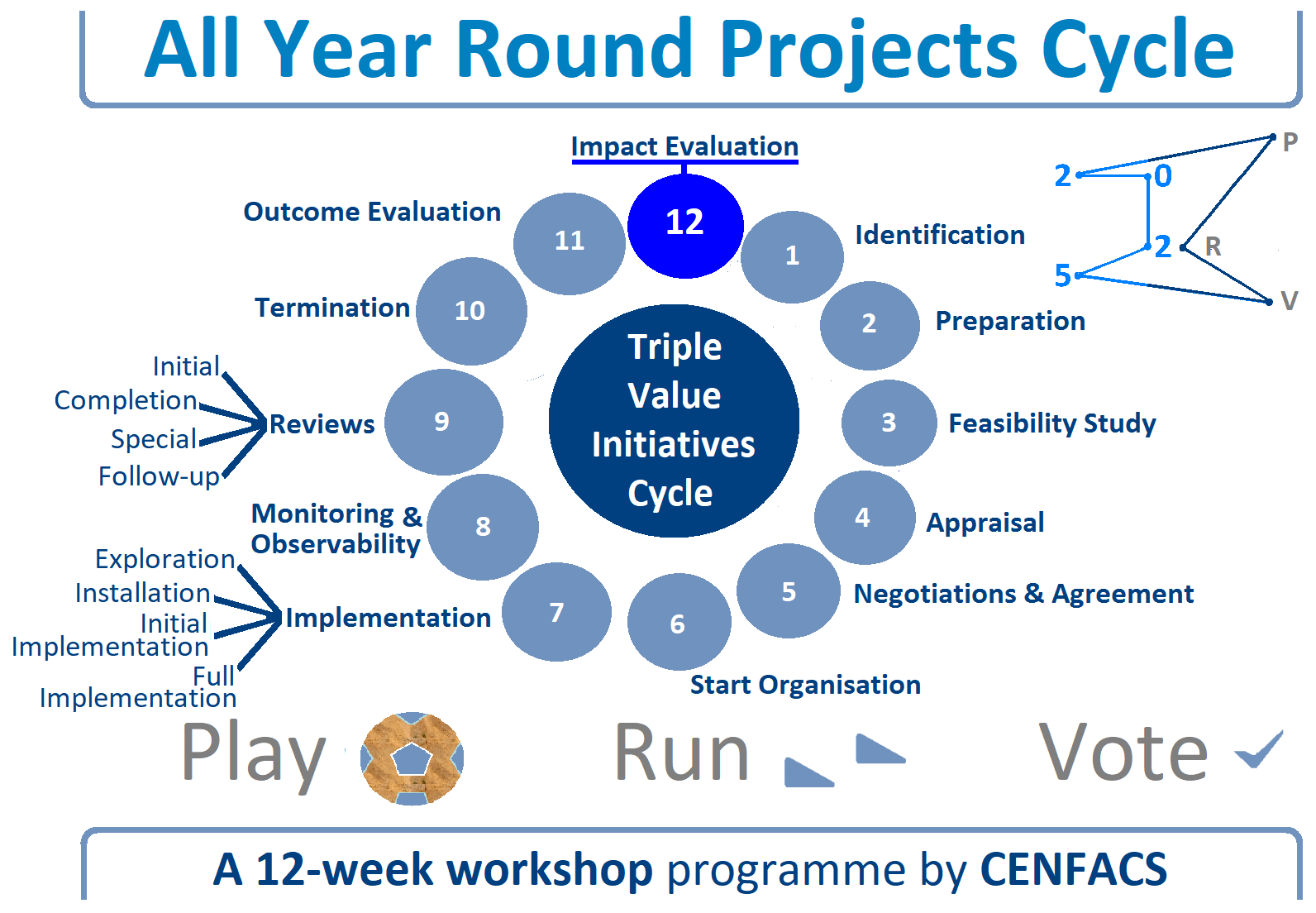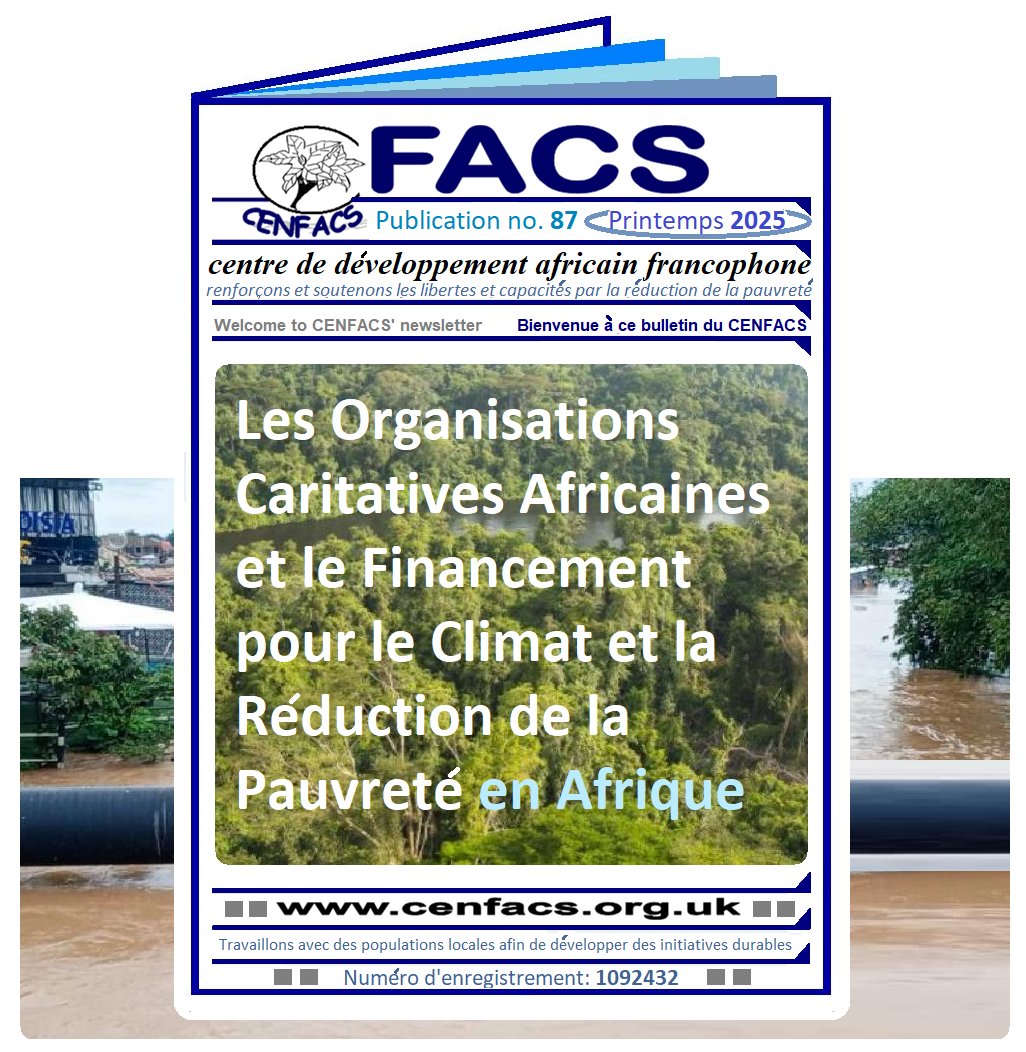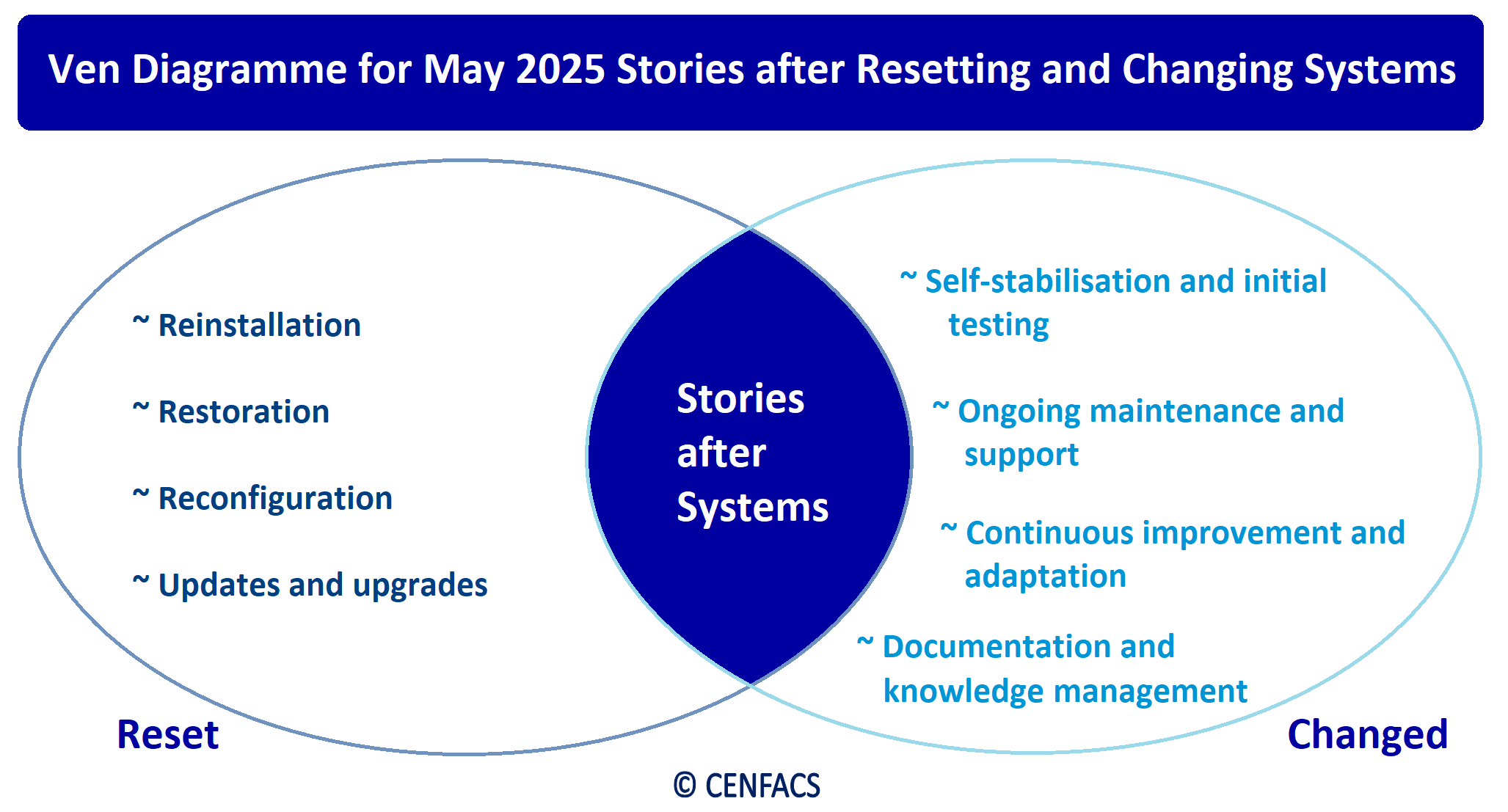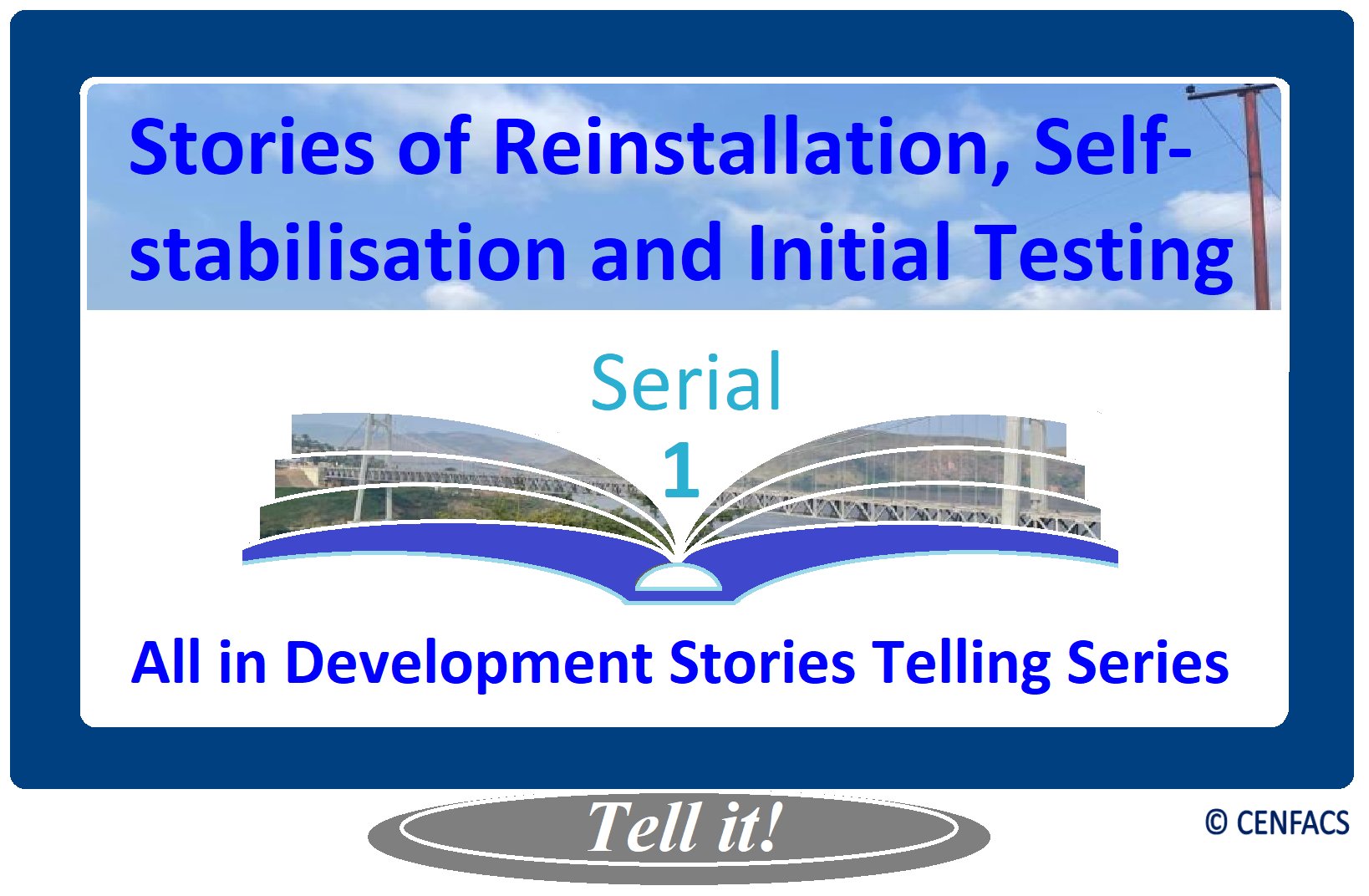Welcome to CENFACS’ Online Diary!
07 May 2025
Post No. 403
The Week’s Contents
• May 2025 Stories – All in Development Stories: Stories after Systems Reset and Change
• All in Development Story Telling Series and Programme 2025
• Activity/Task 5 of the Restoration (R) Year/Project: Tell and Share Restoration Stories
… And much more!
Key Messages
• May 2025 Stories – All in Development Stories: Stories after Systems Reset and Change
Story telling is our main content for the month of May. It is the month and time of the year we dedicate ourselves to telling and sharing poverty relief and sustainable development stories.
• • Why Do We Tell and Share Stories?
This is because in whatever we do to help reduce poverty and appeal for support to enhance the development process we are engaged in, there is always a story to tell and share from various places we intervene and from different individuals and communities or organisations involving in our work.
• • How Do We Tell and Share These Stories?
We do it through All in Development (AiD) Stories project, which is our storytelling project. The project is made of a one month’s storytelling programme and series as explained below.
• • • AiD Storytelling Programme is a one month project that focuses on developing and promoting storytelling skills, techniques and approaches in the specific context of CENFACS‘ community engagement to poverty reduction and sustainable development.
• • • AiD Storytelling Series is a set of related stories presented by CENFACS or volunteer storytellers with a shared theme and a set number of episodes. The series follow a serial format of a continuous story told over multiple episodes.
There is an explanation about this project that can be found under the Main Development section of this post. Every year, there is a different theme for this storytelling project.
• • This Year’s Theme for AiD Stories Project
This year, the theme for AiD Stories Project is about Stories after Resetting and Changing Systems, particularly our system of poverty reduction. They are the stories of a system which has already been reset to meet people’s (poor people’s) needs. Where a system was changed instead of being reset, then stories will be of after a system change.
• • • What are After System Reset and Change Stories?
Let us first explain After Systems Reset Stories, then After Systems Change Stories.
• • • • Stories after a system reset
Depending on the way one has reset its system, they may use the steps they find the most suitable for them after resetting. In the context of AiD Stories Project 2025, we are going to utilise the following steps, which are commonly used in the information, technology and communication environment: reinstallation, restoration, reconfiguration of settings and updates of software. There are relationships between them in order to make our reset system better work.
So, After-system-reset stories are the tales of reinstallation, restoration, reconfiguration and updating of our system of poverty reduction or life.
• • • • Stories after a system reset
Following the type of change initiated to the system, one can use the steps they feel appropriate to them after system change. For the convenience of our AiD Stories Project 2025, we are going to employ the steps that are familiar with what happens in the information technology and communications systems. To be precise, we are using the following steps: stabilisation and verification, communication and training, ongoing maintenance and improvement.
Therefore, After-system-change stories are the accounts of stabilisation and initial testing, ongoing maintenance and support, continuous improvement and adaptation, documentation and knowledge management, and maintenance of our system of poverty reduction or life.
Both stories (after system reset and change stories) are the tales of physical, social, environmental and economic lives and how we try to deal with reset and changed systems, in particular our reset and changed system of poverty reduction.
• • • When will these stories start?
Entries for May 2025 Stories were opened since last March when we announced the general theme of Spring Relief 2025, which is
“moving forward to protect the gains or legacies of our building-forward-better-together work while building upon progress to achieve a more equitable and inclusive society”.
So far, some of our members and supporters have shown some interests. For those who have not yet submitted or told us their stories, this is the month to do it.
These stories are based on a principle.
• • Underlying Principle of AiD Stories Project
The principle of AiD Stories Project is that it is about stories told by volunteers or people who are giving their stories not for money or not being paid for their experience they had in relation to the story theme. However, this principle does not stop anybody to provide a story even if what they are saying come from their paid position.
Besides this general principle, we have two criteria we would like to highlight about the theme of AiD Stories Project for this year.
• • Criteria for the Theme of AiD Stories Project 2025
~ 1st Criterion
For this year’s AiD Stories project, we are mainly interested in Stories of moving forward to protect the gains or legacies of our building-forward-better-together work while building upon progress to achieve a more equitable and inclusive society, as mentioned above. They are the stories of those who hit rock bottom of poverty and hope that a reset and changed system can provide them an opportunity to bounce forward in a sustainable way.
~ 2nd Criterion
We are registering people’s personal experiences of being or at risk of being left behind in the process after the system has been reset or changed.
Indeed, experiences show that in many cases after resetting and changing systems, not all people receive equal support or benefit resulting from new systems (or reset or changed systems). There is always a possibility that aid (or help or income) that has been transferred to vulnerable people and households does not reach everybody or if its does it does not reach them proportionally or equally. For those who have not been reached, their personal stories need to be heard as well.
Additionally, we would like to select amongst submitted stories the best ones.
• • Selecting the Top Real True Story of the Month
This year, we would like to select the top three stories of poverty reduction of the month and the real true story of poverty reduction of the month. To do that we will use impact story approach. This approach is often used when monitoring, observability and evaluation are restricted. What do we mean by that?
We mean what ‘civicus.org’ (1) says about impact stories, which is:
“Impact stories are a useful way to systematically documenting anecdotal evidence that expected activities occurred, and the perceived results thereof”.
Our storytelling assessors will try to capture elements of storytelling that respond to our storytelling criteria. Stories that build inclusion and inspire people after system reset or change have more chance to win more votes or points than other ones.
To facilitate and organise ourselves in the way of telling these stories, we are going to do it through a series or programme or a timeline of scripts. There is more information about this series below.
For more information on AiDS project and this year’s storytelling focus and scripts, please read under the Main Development section of this post.
To tell your story after reset and change for change to CENFACS, please contact CENFACS for story telling terms and conditions.
• All in Development Story Telling Series and Programme 2025
The 2025 series of AiDS Telling Programme started from the 1st of May 2025, every Wednesday afterwards and will last until the end of May 2025. These series, which are part of May 2025 Stories, are a timeline of scripts or a set of notes arranged in line to tell and share Stories after System Reset and Change. But, these stories do not need to be linear (that is, problem > action > solutions). We take non-linear stories as well.
To arrange this programme, we are going to utilise the four steps below, which are commonly used by theoreticians and practitioners in distributed computing and communication networks after resetting a system: reinstallation, restoration, reconfiguration of settings and updates of software. We are going to apply these steps to the fields of poverty reduction, humanitarian relief and sustainable development.
Let us briefly explain these steps.
a) Reinstall
After resetting your poverty reduction system, the contents of this system will removed. You will need to put them in place and make them ready for use again or the reset ones.
b) Restore
You need as well to bring these contents back to a normal or proper state, or restore them from a back-up.
c) Reconfigure settings
You will need to reset these contents to their default values and to your preferences.
d) Updates and upgrades of our system for poverty reduction
When doing reset, please make sure to check for and install any available updates or upgrades.
We are also referring to the steps that are familiar with what happens in the information technology and communications systems when changing a system. The steps below can be used after changing a system.
i) Stabilisation and verification
There are about testing the new system to ensure it correctly functions and meets the requirements, tracking the system’s performance and identifying any potential problems, and addressing any issues or bugs that arise during the initial phase of operations.
ii) Communication and training
It is about communicating the change to all relevant stakeholders (e.g., project users and beneficiaries, Africa-based Sister Organisations, funders/donors, volunteers and other supporters, etc.), explaining how to effectively use the new system, and documenting all the changes made to the system.
iii) Ongoing maintenance
It is about ensuring the system is kept up-to-date with security patches and updates, continuously monitoring the system’s performance and optimising it as needed, gathering feedbacks
iv) Improvement
It is about identifying areas for improvement, maintaining and updating the relevant documentation to the system.
From the above-mentioned four steps from each system (that is, reset and changed systems), we can organise our stories line. There is no single logic or model of organising a story. We thought that to make it easier, our storytelling series for reset and changed systems will follow these four plus four (4+4) model or two-story sequences:
The four plus four (4+4) or two-story sequences can be linked each other in a sequential way.
For further details about these two-story sequences or timeline of AiD scripts, please continue to read under the Main Development section of this post.
• Activity/Task 5 of the Restoration (R) Year/Project: Tell and Share Restoration Stories for Poverty Reduction
The fifth activity/task of the “t” Project is about sharing with those in need some inspiring stories about restoration. But, what is a restoration story?
• • Brief Explanation of Restoration Story
A restoration story can refer to several related concepts like the following ones:
a) the narrative structure of narratives where a hero overcomes disorder and restores order;
b) the retelling of personal stories in light of a larger narrative of restoration, often in a religious or spiritual context; and
c) stories showcasing the real-world experiences and outcomes of ecological restoration projects.
The above-mentioned concepts of restoration story can be told and shared as a way of completing Activity/Task 5 of the Restoration (R) Year/Project.
• • Telling and Sharing Your Story of Restoration for Poverty Reduction
One can tell and share their experiences, successes and challenges of real ecological restoration projects or activities to inspire efforts of poverty reduction. These experiences, successes and challenges can be comprehensive from conception to post-restoration monitoring. Other ones could be more analytic.
For instance, the website ‘eauk.org’ (2) states Tearfund’s Restoration Story, which is a film that tells stories of Christians all over the world who are coming together to tackle poverty, inequality and climate change – through living differently praying and speaking out.
So, Activity/Task 5 of the Restoration (R) Year/Project is about Telling and Sharing Your Restoration Story for Poverty Reduction.
For those who need any help before embarking on this activity/task, they can speak to CENFACS.
For any other queries and enquiries about the ‘R‘ project and this year’s dedication, please contact CENFACS as well.
Extra Messages
• Goal of the Month: Reduction of Ecological Poverty through Restoration Stories
• Climate-resilient Asset Building Programme for Households – In Focus from 07/05/2025: Financial Incentives
• All-year Round Projects Cycle (Triple Value Initiatives Cycle) – Step/Workshop 12: Impact Evaluating Your Play, Run and Vote Projects
• Goal of the Month: Reduction of Ecological Poverty through Restoration Stories
Our goal of the month is linked to Activity/Task 5 of the Restoration (R) Year/Project, which is Telling and Sharing Your Restoration Story for Poverty Reduction.
In order to meet this goal, it is better to understand ecological poverty, then to explain how restoration stories can help improve one’s efforts to reduce and possibly end poverty.
• • What Is Ecological Poverty?
Ecological poverty can be defined in various ways. One of its definitions comes from ‘ncesc.com’ (3) which argues that
“Ecological poverty is the lack of an ecologically healthy natural resource base that is needed for a human society’s survival and development. It is not the economist’s Gross National Product that matters to them. It is the decline of the Gross Nature Product that matters to them”.
The decline of the Gross Nature Product matters to us to deal with poverty that this decline is causing.
• • How Stories Can Help Reduce Poverty
Telling and sharing real life stories can help people who listen to them to shift their perceptions of poverty and build support for anti-poverty measures, programmes and policies. By drawing on what the website ‘commonslibrary.org’ (4) states, your stories can help
~ bring the social setting to the foreground
~ shift the public discourse broadly
~ foreground social justice
~ challenge stereotypes
~ amplify voices on poverty issues
etc.
In short, restoration stories can increase understanding and activate hope to solve ecological poverty.
• • Implications for Selecting the Goal for the Month
After selecting the goal for the month, we focus our efforts and mind set on the selected goal by making sure that in our real life we apply it. We also expect our supporters to go for the goal of the month by working on the same goal and by supporting those who may be suffering from the type of poverty linked to the goal for the month we are talking about during the given month (e.g., May 2025).
For further details on the goal of the month, its selection procedure including its support and how one can go for it, please contact CENFACS.
• Climate-resilient Asset Building Programme for Households – In Focus from 07/05/2025: Financial Incentives
To treat the above-mentioned focus, let us first provide the meaning of financial incentives, then relate it to households, especially to vulnerable ones.
• • What Is Financial Incentive?
Financial incentives can be of various types. However, there is a convergence in its definitions. Without stating many of its definitions, let us limit to the one given by ‘getcompass.ai’ (5) which is:
“A financial incentive is a reward or benefit offered to individuals or entities to encourage specific actions or behaviours. These incentives are typically monetary in nature and can take various forms, such as bonuses, commissions, profit-sharing, stock options, salary increases or performance-base pay”.
This definition is related to financial incentives offered by businesses. They are financial incentive programmes are run by employers to encourage greater productivity and loyalty among employees.
The website also adds that other entities (like governments and other organisations) can give financial incentives. Both financial incentives run by businesses and other entities can benefit households.
• • Households’ Access to Financial Incentives
Households can access a number of financial incentives. They can access at their work place if they are working; just as they can be eligible for some types financial incentives which are not work-related.
For instance, there are many types of financial incentives that vulnerable households can get which include the following:
~ financial incentive for reducing electricity use during peak periods
~ a free cash payment to help with the cost of living through Government’s Household Support Fund Scheme
~ help to pay for essentials like energy bills and food
~ council tax support to help pay council tax bill for those who cannot afford
~ discretionary housing payments to deal with rent shortfalls, rent arrears, deposits, and moving costs
etc.
These incentives and related products to incentivize households are available and households, in particular the poorest ones, are required to learn, know about them and apply for them.
Those households that are unaware of them, this is the opportunity to conduct some research about them if they want to build climate-resilient assets. If they have some difficulties in getting information and guidance about them, they can work with CENFACS.
For those households that would like to build climate-resilient asset via Financial Incentives, they should not hesitate to contact CENFACS.
For any queries and/or enquiries about Financial Incentives in the context of Climate-resilient Asset Building Programmes for Households (including how to access this programme), please do not hesitate to contact CENFACS.
• All-year Round Projects Cycle (Triple Value Initiatives Cycle) – Step/Workshop 12: Impact Evaluating Your Play, Run and Vote Projects
In Step/Workshop 11 of your Play, Run and Vote Projects, you conducted an outcome evaluation by measuring your behaviour, participation to and achievement following the delivery of these projects. Now, you can proceed with an impact evaluation. An impact evaluation will help to evaluate the effect of your Play, Run and Vote Projects on you and the environment surrounding you. But, what is an impact evaluation?
• • Basic Understanding of an Impact Evaluation
The definition we have chosen to understand an impact evaluation comes from ‘betterevaluation.org’ (6). According to ‘betterevaluation.org’,
“An impact evaluation provides information about the impacts produced by an intervention. The intervention might be a small project, a large programme, a collection of activities, or a policy”.
The same ‘betterevaluation.org’ states that
“A impact evaluation can be undertaken to improve or reorient an intervention (i.e., for formative purposes) or to inform decisions about whether to continue, discontinue, replicate or scale up an intervention (i.e., for summative purposes)”.
In other words, an impact evaluation tries to measure the difference between outcomes with an intervention and without it in a way that can attribute the difference to the intervention, and only the intervention.
For instance, an impact evaluation of your Run Project will assess changes in your wellbeing that can be attributable to your Run Project. The figure below is an impact evaluation exercise showing how your all-year-round project can impact on you.

To carry out an impact evaluation, one needs to answer/know the why, when, what and who to engage in the evaluation process. Also, one can base its impact evaluation on a particular way of thinking or a theory.
• • Theories to Be Used in Your Impact Evaluation
To simplify the matter, an all-year-round project beneficiary will use a theory of change that will guide them to causal attribution or to answer cause-and-effect questions; meaning that changes in outcome are directly attributable to an intervention (here your Play, Run and Vote Projects). Therefore, you need to better plan and manage your impact evaluation.
• • Example of Planning and Managing the Impact Evaluation of Your All-year Round Projects
To better plan and manage the impact evaluation of Your All-year Round Projects, you can proceed with the following:
σ Describe what needs to be evaluated
σ Identify and mobilise resources for your evaluation
σ Decide who will conduct the evaluation and engage it
σ Set up an evaluation methodology/approach/technique
σ Manage your evaluation work
σ Implement your evaluation work
σ Evaluate the result/impact of Your All-year Round Projects on you and/or others
σ Share your evaluation results/report.
The above is one of the possible ways of impact evaluating your All-year Round Projects. For those who would like to dive deeper into Impact Evaluation of their Play or Run or Vote project, they should not hesitate to contact CENFACS.
• • Concluding Note about This 12-week Workshop Programme
To conclude this 12-week workshop programme, we would like to thank those who have been engaged with it.
We would like to ask to those who can to measure the impact and effectiveness in working with them/you on how to plan, execute and evaluate your All-year Round Projects.
For example, they/you can state that on overall they/you have positive or negative impacts from this programme. They/you can send your statement to CENFACS‘ usual contact details as given on this website.
Those who need help for any aspect of the plan of their All-year Round Projects, they should not hesitate to contact CENFACS.
Good luck with their/your All-year Round Projects!
Message in French (Message en français)
• Numéro 87 de FACS du Printemps 2025, qui s’intitule ‘Les Organisations Caritatives Africaines et le Financement pour le Climat et la Réduction de la Pauvreté en Afrique’
Le 87e numéro de la FACS traite des stratégies et des outils que les Organisations Caritatives Africaines (OCA) utilisent ou peuvent utiliser pour entreprendre la planification et la budgétisation climatiques, ainsi que pour formuler leur offre d’investissement afin de rechercher et d’obtenir ou de mobiliser des fonds.
Le 87e numéro de FACS est une étude sur la façon dont les OCA tentent d’accéder à des fonds par le biais d’institutions locales dotées de capacités et d’autonomisation où elles opèrent. C’est sans ignorer les efforts qu’elles peuvent faire pour travailler avec le secteur privé ou à but lucratif sur les questions de changement climatique. En d’autres termes, le numéro 87 de FACS est une enquête sur la façon dont les OCA tentent de collaborer et de s’associer avec d’autres pour améliorer leur capacité et leur coordination à gérer les questions liées au financement de la lutte contre le changement climatique.
Le numéro 87 traite également du financement de la réduction de la pauvreté. En effet, obtenir un financement climatique n’implique pas nécessairement obtenir des financements pour la réduction de la pauvreté. C’est pourquoi, il y a lieu de travailler également sur l’utilisation d’instruments financiers qui permettent aux OCA d’accéder à des fonds et de répondre aux besoins de leurs bénéficiaires et des habitant(e)s. À cet égard, le 87e numéro vise à vérifier s’il y a ou non un alignement entre la stratégie des OCA en matière de financement du climat et de financement de la réduction de la pauvreté. Et s’il y en a, où mène cet alignement.
Le 87e numéro analyse la relation entre le financement de l’action climatique et le financement de la réduction de la pauvreté. Plus précisément, il met en évidence l’interdépendance entre le changement climatique et la pauvreté. On sait que le changement climatique peut exacerber la pauvreté en provoquant des catastrophes naturelles, l’insécurité alimentaire et les déplacements; tandis que la pauvreté peut rendre les personnes et les communautés plus vulnérables aux impacts climatiques.
Loin d’être un catalogue de défis et d’obstacles, le 87e numéro se penche sur l’amélioration des stratégies de financement des OCA en ce qui concerne les questions de climat et de réduction de la pauvreté. En particulier, le 87e numéro fait valoir ce qui suit :
σ l’intégration entre la stratégie de financement de l’action climatique et la stratégie de financement de la réduction de la pauvreté, car il existe des avantages connexes et des synergies entre la réduction du changement climatique et les initiatives de réduction de la pauvreté
σ un modèle de collaboration entre les OCA et tous les autres acteurs pour mobiliser le financement de l’action climatique et le financement de la réduction de la pauvreté et du développement durable
σ l’alignement entre le financement de l’action climatique et le financement de la réduction de la pauvreté
σ l’amélioration de la planification des projets des OCA qui ne reflète pas seulement les besoins du climat, mais qui prenne également en compte la demande de ceux ou celles qui vivent dans la pauvreté en Afrique
σ le suivi des fonds climatiques et des fonds pour la réduction de la pauvreté et le développement durable
σ l’élaboration de cadres qui incluent à la fois l’investissement climatique et l’investissement d’impact dans la réduction de la pauvreté
σ l’amélioration de la planification et de la coordination entre les projets de lutte contre le changement climatique et les projets de réduction de la pauvreté.
Pour lire les résumés clés de ce nouveau numéro, veuillez contacter le CENFACS.
Main Development
• May 2025 Stories – All in Development Stories: Stories after Systems Reset and Change
The items making the contents of May 2025 Stories include the following:
∝ What is All in Development Stories Project?
∝ May 2025 Stories: Stories after Systems Reset and Change
∝ Story Telling Sequences or Series
∝ AiDS Serial 1: Stories of Reinstallation and Stabilisation (Starting from Wednesday 07/05/2025)
∝ Further Information about May 2025 Stories.
Let us highlight each of these elements.
• • What Is All in Development Stories Project?
All in Development Stories (AiDS) is a life story building, developing, telling, sharing and learning project set up by CENFACS in 2009 in order to give opportunities to volunteers, interns and other development supporters and enthusiasts to inspire others and spread the good news and will of better change to the community. It is also a narrative approach to documenting and managing features, tasks and project progress that has features or properties, storytelling programme and series.
• • • AiDS Properties
The project, which is run during the month of May, has six properties as follows:
1) AiDS is a telling and sharing story
It is about telling and sharing with us your experience and achievements made in the fields of local (UK) and International (Africa) developments.
2) AiDS is an expression of the problem
It expresses the problem (of poverty) to be solved, the user’s or project beneficiary’s perspective, and the desired outcome.
3) AiDS is a learning and development process
It is also about learning from volunteers and interns how they improved their own life, changed deprived lives and reached out to the needy communities. After learning, one can try to develop strengths and better practices to solve problems.
4) AiDS is an inspirational and motivational support network
The project seeks to inspire and motivate others on the road of change for better change; especially for those (who are part of our network and those who would like to be part of it) who might prepare and use their summer break or any other occasions to take up volunteering and or internship roles and positions.
5) AiDS is a building storytelling skills initiative
It helps story tellers to develop skills to tell and supply stories (stories generation) to meet the demand of stories listeners (stories heard) in order to connect those in need to poverty reduction. These stories that connect to poverty reduction can be linear and non-linear as well as deliberately action-oriented.
6) AiDS finally is a state-of-the-art project
After all, it is the art of poverty relief telling story that enables us to get up-to-date information, knowledge and thinking in the fields of poverty reduction and sustainable development from those who went on the grounds to learn and experience real-life development works. They return with volunteering stories to tell and share. As the National Storytelling Network (7) puts it in these terms:
“Storytelling is the interactive art of using words and actions to reveal the elements and images of a story while encouraging the listener’s imagination”.
• • • AiDS Telling Programme
The programme, which is a short-term project (of one month in May), focusses on the process of storytelling by developing and promoting storytelling skills, techniques and approaches with the purpose of enhancing communication, creativity, empathy, and engagement to poverty reduction and sustainable development.
The programme uses narratives, stories and personal anecdotes to enhance engagement, comprehension, and retention of information relating to poverty reduction and sustainable development.
• • • AiDS Telling Series
It is a set number of episodes or chapters with a defined beginning and end that focuses on presenting a collection of related stories with the purpose of engaging audiences, exploring themes, and developing narratives. Through this series, stories will be shared with an audience in a serial format or a continuous story told over multiple episodes.
This year’s storytelling and sharing will be about Stories after System Reset and Change.
• • May 2025 Stories: Stories after System Reset and Change
Before highlighting these stories, let us explain the key terms where these stories would originate.
• • • Key Terms leading to After System Reset and Change
They are the terms we can use after resetting and changing our systems of poverty reduction. These terms are given below.
• • • • Key terms after a system reset
Depending on the way one has reset its system, they may use the steps they find the most suitable for them after resetting. In the context of May 2025 Stories, we are going to utilise the following steps, which are commonly used in the information, technology and communication environment: reinstallation, restoration, reconfiguration of settings and updates of software. The words or expressions used for these steps make up the key terms after our system reset. Let us highlight these terms.
• • • • • Reinstall
After resetting your poverty reduction system, the contents of this system will removed. You will need to put them in place and make them ready for use again or the reset ones.
• • • • • Restore
You need as well to bring these contents back to a normal or proper state, or restore them from a back-up.
• • • • • Reconfigure settings
You will need to reset these contents to their default values and to your preferences.
• • • • • Updates and upgrades of our system for poverty reduction
When doing reset, please make sure to check for and install any available updates and upgrades.
The above-mentioned expressions or words or verbs are the ones we shall use after resetting our poverty reduction systems. There are also relationships between them in order to make our reset system better work.
• • • • Key terms after a system change
Following the type of change initiated to the system, one can use the steps they feel appropriate to them after system change. For the convenience of our May 2025 Stories, we are going to employ the steps that are familiar with what happens in the information technology and communications systems. To be precise, we are using the following steps: stabilisation and verification, communication and training, ongoing maintenance and improvement. The terms used for these steps constitute the key terms or terminology after our system change. Let us briefly explain these terms.
• • • • • Stabilisation and verification
There are about testing the new system to ensure it correctly functions and meets the requirements, tracking the system’s performance and identifying any potential problems, and addressing any issues or bugs that arise during the initial phase of operations.
• • • • • Communication and training
It is about communicating the change to all relevant stakeholders (e.g., project users and beneficiaries, Africa-based Sister Organisations, funders/donors, volunteers and other supporters, etc.), explaining how to effectively use the new system, and documenting all the changes made to the system.
• • • • • Ongoing maintenance and improvement
It is about ensuring the system is kept up-to-date with security patches and updates, continuously monitoring the system’s performance and optimising it as needed, gathering feedbacks to identify areas for improvement, maintaining and updating the relevant documentation to the system.
The above key terminology will help to generate the types of May 2025 Stories after System Reset and Change.
• • • What are Stories after System Reset and Change?
Reset System Stories or Stories after resetting system are
• the sequencing tales of reinstallation
• the narratives of restoration
• the histories of reconfiguration
• the tellings of updating and upgrading our system of poverty reduction or life.
Changed System Stories or Stories after changing system are
• the accounts of stabilisation and initial testing
• the plots of ongoing maintenance and support
• the anecdotes of continuous improvement and adaptation
• the reports of documentation and knowledge management of our system of poverty reduction or life.
Both After System Reset and Change Stories will be presented via AiD Story Telling programme. They can be compared and contrasted in terms of their similarities and differences. One can even use Ven Diagramme to compare and contrast these/their stories.
During this month of May, we are running 4+4 or two-story series of AiD Story Telling programme that will revolve around the process of ‘Moving forward to protect the gains or legacies of our building-forward-better-together work while building upon progress to achieve a more equitable and inclusive society.
For those who want to tell their Stories after Resetting and Changing Systems; they can choose among the following sequences to tell their stories.
• • Story Telling Sequences or Series
AiD Story Telling Series: Starting on 07/05/2025 and after every Wednesday until the end of May 2025
The following two-story series or sequences have been planned for this month of storytelling (May Stories).
σ Serial 1: From Wednesday 07/05/2025: Stories of Reinstallation, and Self-stabilisation and Initial Testing
σ σ Stories of Reinstallation are the sequencing tales of putting our poverty reduction system in place so that it is ready for use and for deliver its results.
σ σ Stories of Self-stabilisation and Initial Testing are the accounts relating to our poverty reduction system’s ability to recover automatically from unexpected faults, as well as of ensuring the quality, safety and effectiveness of the processes and products of system of poverty reduction.
σ Serial 2: From Wednesday 14/05/2025: Stories of Restoration, and Ongoing Maintenance and Support
σ σ Stories of Restoration are the narratives of any action or process used to repair, re-establish, or renew tangible and intangible assets.
σ σ Stories of Ongoing Maintenance and Support are the plots relating to regular upkeep, and updates, and keeping system from falling.
σ Serial 3: From Wednesday 21/05/2025: Stories of Reconfiguration and Continuous Improvement and Adaptation
σ σ Stories of Reconfiguration are the histories of rearranging the elements or settings of a poverty reduction system or life
σ σ Stories of Continuous Improvement and Adaptation are the anecdotes of uninterrupted amelioration and fitting into new circumstances and situations.
σ Serial 4: From Wednesday 28/05/2025: Stories of System Updating and Upgrading, and Documentation and Knowledge Management
σ σ Stories of System Updating and Upgrading are the tellings of renewing our system by replacing older versions, enhancing functionality and reducing system vulnerabilities.
σ σ Stories of Documentation and Knowledge Management are the reports of making the information more relatable and easier to understand, and of ensuring knowledge of our poverty reduction system remains accurate, up-to-date and useful.
Both Stories after System Reset and Change will help us Moving forward to protect the gains or legacies of our building-forward-better-together work while building upon progress to achieve a more equitable and inclusive society.
• • AiDS Serial 1: Stories of Reinstallation, and Self-stabilisation and Initial Testing (Starting from Wednesday 07/05/2025)
We have two stories from our two-story model: Stories of Reinstallation and Stories of Self-stabilisation and Initial Testing. Let us look at each of them.
• • • Stories of Reinstallation
To present these stories, let us first try to briefly explain a reinstallation, then provide the stories linked to it.
• • • • Brief explanation of reinstallation
Reinstallation is the process of putting in place a machine or equipment and making it ready for use. This is done often to resolve a problem or update the system. In the context of May 2025 Stories, we are going to reinstall our system of poverty reduction.
Reinstallation can provide a story. In this respect, reinstallation story can refer to the narrative or experience surrounding this process including the reasons for reinstallation and the troubleshooting steps taken.
• • • • Stories of Reinstallation
As said above, these stories are those of putting in place our system of poverty reduction so that it is ready for use and for delivery of its results. In other words, they are the stories of performing all the necessary system configuration steps to make it ready to use. It means running the programme’s installer.
From this definition, we have identified the following stories of reinstalling our system of poverty reduction:
a) the reinstallation stories of fixing issues like system conflicts
b) the storytelling infographics of resolving persistent problems
c) the fables, written or spoken, made of words, voices and tones of the frustration of a corrupted system or the relief of a successful reinstall
d) the tales of the problems encountered, the solutions attempted and the final outcomes.
If you are a member of our community and have this type of story, please do not hesitate to tell and share your story with CENFACS. If you are not our member, you can still submit your story.
To donate, tell and share your storying gift of Stories of Reinstallation, please contact CENFACS.
• • • Stories of Self-stabilisation and Initial Testing
To understand these stories, let us first explain self-stabilisation and initial testing, then identify stories relating to them.
• • • • Short explanation of self-stabilisation
On the website ‘direct.mit.edu’ (8), self-stabilisation is defined as
“A system’s ability to recover automatically from unexpected faults”.
It is the ability of a system to reach a legitimate state (a correct or desired state) from any arbitrary initial state, even if it is caused by transient faults.
This concept is used in the field of distributed computing and fault tolerance to highlight the ability of a system to self-correct and maintain its functionality even in the face of unexpected events. The concept can also be applied in the fields of poverty reduction and sustainable development.
From this definition, it is possible to explain a story of self-stabilisation.
• • • • Stories of Self-stabilisation
A story of self-stabilisation refers to a narrative that illustrates how a system or process can automatically recover from faults or disturbances and return to a stable, desirable state.
From this definition, it can be argued that Stories of Self-stabilisation are
a) the accounts of system’s autonomous recovery without external intervention
b) the anecdotes of system detecting and correcting the effects of the faults without external intervention
c) the narratives of system returning to a stable state
d) the records of tones of voice a system’s resilience and its capacity to withstand challenges, learn from them and return to reliable state
e) the tales of explaining the nature of the faults or disturbances.
These stories can be used to communicate the ability of our system of poverty reduction to self-stabilise without external intervention.
For example, these stories can help to know how those involved in community-led systems can change initiatives by telling compelling stories about the nature and impact of their work or how these stories can be used to enable and celebrate community-led systems change work.
If you are a member of our community and have this type of story, please do not hesitate to tell and share your story with CENFACS. If you are not our member, you can still submit your story.
To donate, tell and share your storying gift of Stories of Self-stabilisation, please contact CENFACS.
• • • • Short explanation of initial testing
Within the literature relating to the field of distributed computing and fault tolerance, initial testing refers to the first set of evaluations or examinations conducted to determine the functionality or characteristics of something, usually at the beginning of a process or before significant changes are made. It is a way to identify potential issues early on, ensuring safety and efficiency later.
After conducting initial testing of our new system of poverty reduction, there could be stories to tell and share.
• • • • Stories of Initial Testing
These stories will be about ensuring the quality, safety and effectiveness of the processes and products making our newly changed system of poverty reduction. They are also the narratives that explain how one can avoid problems down the line via initial testing of the new system.
If you are a member of our community and have this type of story, please do not hesitate to tell and share your story with CENFACS. If you are not our member, you can still submit your story.
To donate, tell and share your storying gift of Stories of Initial Testing, please contact CENFACS.
• • Further Information about May 2025 Stories
• • • 2025 Story Areas of Interest
We normally take stories that cover any areas of poverty reduction and local and international sustainable developments.
• • • Contexts of Stories
Stories could come from any level of project/programme cycle (i.e. planning, implementation, monitoring, evaluation and review) as long as it is to do with poverty reduction and sustainable development.
They could also be a result of research and field work activities or studies.
They could finally be an experience of everyday life.
• • • Call for 2025 Entries
As said above, the 2025 Edition of AiDS has already kicked off. For those who want to enter their stories of life renewal, please note you are welcome to do so.
Just read below the annotated timetable for story submission and CENFACS’ storytelling terms and conditions.
We await your responses to our call.
• • • Annotated Timetable for Story Submission in 2025
∝ Start of online (e-mail) and paper-based submission (01/05/2025)
∝ Story submission deadline (31/05/2025)
∝ Notification of receipt/acceptance (by 17/06/2025)
∝ Submission of revised stories (01 to 31/05/2025)
• • • Storytelling Check List
Before submitting, please check that your story meets the following:
√ Relatable
√ Relevant
√ Engaging
√ Inspiring
√ Building inclusion
√ Poverty-relieving
• • • CENFACS Story Telling & Sharing Terms
To tell and/or share your May story, please let us know the following:
√ who you are
√ where and when your experience took place
√ and of course the story itself.
You could also
√ text
√ twit
√ record voice/video
√ send some forms of supporting materials/resources to back up your story.
Should you wish not to be name, please let us know your decision.
Please see below our story telling, sharing and learning terms.
• • • CENFACS story telling, sharing and learning terms
1) We welcome told, untold, linear and non-linear stories
2) Inside, witness, news, behind the scenes and case stories are eligible
3) We only take real life stories, not fiction stories or fake news or artificial stories
4) Tell true and evidence-based stories only, not lies
5) If possible, back up your stories with facts and data (numerical or textual or voice or video or even infographics)
6) Mention location, dates and names of events in the story
7) We accept photos, images, pictures, videos, info-graphic materials, audios and other forms of resources (e.g. digital or e- technologies) to support, capture and communicate the impact of your story
8) Plagiarism, prohibited, offensive, violation of copyrights and unlawful/illegal materials are not accepted
9) Hacking, flaming, spamming, scamming, ransom ware, phishing and trolling practices are not accepted as well
10) We greatly consider stories building on inclusion, inspiring people to change, containing poverty-relieving elements and highlighting nature-based solutions to poverty and hardships.
For further clarification, contact CENFACS.
Tell and share your storyline of change for change by communicating the impact you make!
CENFACS is looking forward to engaging with you through your story. If you have any questions, please do not hesitate to reach out to CENFACS at facs@cenfacs.org.uk.
_________
• References
(1) https://www.civicus.org/monitoring-toolkits/toolkit/impact-story/ (Accessed in May 2023)
(2) https://www.eauk.org/resources/member-resources/discipleship/earfund-restoration-story (accessed in May 2025)
(3) https://www.ncesc.com/geographic-faq/what-is-environmental-poverty/# (accessed in May 2025)
(4) https://commonslibrary.org/talking-about-poverty-narratives-counter-narratives-and-telling-effective-stories (accessed in May 2025)
(5) https://www.getcompass.ai/glossary/financial-incentives (accessed in May 2025)
(6) https://www.betterevaluation.org/methods-approaches/themes/impact-evaluation (Accessed in May 2023)
(7) https://storynet.org/what-is-storytelling/ (Accessed in May 2023)
(8) https://direct.mit.edu/books/monography/3220/Self-stabilisation (accessed in May 2025)
_________
• Help CENFACS Keep the Poverty Relief Work Going This Year
We do our work on a very small budget and on a voluntary basis. Making a donation will show us you value our work and support CENFACS’ work, which is currently offered as a free service.
One could also consider a recurring donation to CENFACS in the future.
Additionally, we would like to inform you that planned gifting is always an option for giving at CENFACS. Likewise, CENFACS accepts matching gifts from companies running a gift-matching programme.
Donate to support CENFACS!
FOR ONLY £1, YOU CAN SUPPORT CENFACS AND CENFACS’ NOBLE AND BEAUTIFUL CAUSES OF POVERTY REDUCTION.
JUST GO TO: Support Causes – (cenfacs.org.uk)
Thank you for visiting CENFACS website and reading this post.
Thank you as well to those who made or make comments about our weekly posts.
We look forward to receiving your regular visits and continuing support until the end of 2025 and beyond.
With many thanks.
